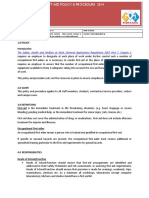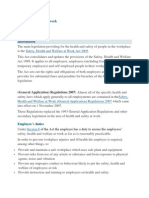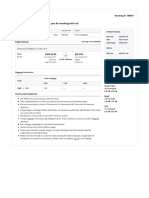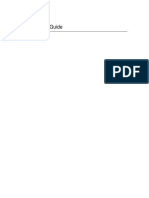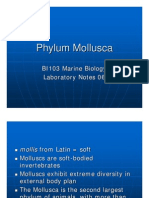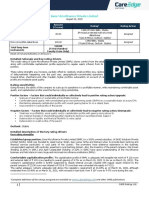0 ratings0% found this document useful (0 votes)
101 viewsDefinitions
Definitions
Uploaded by
khairulhakamThis document defines key terms related to first aid in the workplace such as first-aider, first aid facilities, and universal precautions. It outlines the legal requirements for employers to provide first aid services including maintaining a first aid box and assigning responsible persons. The major components of workplace first aid are identified as first-aiders, first aid boxes/rooms, and first aid equipment/manuals. Factors to consider for first aid provisions include industry type, workforce size, and location.
Copyright:
© All Rights Reserved
Available Formats
Download as DOCX, PDF, TXT or read online from Scribd
Definitions
Definitions
Uploaded by
khairulhakam0 ratings0% found this document useful (0 votes)
101 views9 pagesThis document defines key terms related to first aid in the workplace such as first-aider, first aid facilities, and universal precautions. It outlines the legal requirements for employers to provide first aid services including maintaining a first aid box and assigning responsible persons. The major components of workplace first aid are identified as first-aiders, first aid boxes/rooms, and first aid equipment/manuals. Factors to consider for first aid provisions include industry type, workforce size, and location.
Original Description:
DEFINATION
Copyright
© © All Rights Reserved
Available Formats
DOCX, PDF, TXT or read online from Scribd
Share this document
Did you find this document useful?
Is this content inappropriate?
This document defines key terms related to first aid in the workplace such as first-aider, first aid facilities, and universal precautions. It outlines the legal requirements for employers to provide first aid services including maintaining a first aid box and assigning responsible persons. The major components of workplace first aid are identified as first-aiders, first aid boxes/rooms, and first aid equipment/manuals. Factors to consider for first aid provisions include industry type, workforce size, and location.
Copyright:
© All Rights Reserved
Available Formats
Download as DOCX, PDF, TXT or read online from Scribd
Download as docx, pdf, or txt
0 ratings0% found this document useful (0 votes)
101 views9 pagesDefinitions
Definitions
Uploaded by
khairulhakamThis document defines key terms related to first aid in the workplace such as first-aider, first aid facilities, and universal precautions. It outlines the legal requirements for employers to provide first aid services including maintaining a first aid box and assigning responsible persons. The major components of workplace first aid are identified as first-aiders, first aid boxes/rooms, and first aid equipment/manuals. Factors to consider for first aid provisions include industry type, workforce size, and location.
Copyright:
© All Rights Reserved
Available Formats
Download as DOCX, PDF, TXT or read online from Scribd
Download as docx, pdf, or txt
You are on page 1of 9
DEFINITIONS
First-aid in the workplace includes the provision of first-aid facilities, services
and personnel required for the initial treatment of persons suffering from injury
or illness at a workplace. It is the immediate treatment or care given to a victim
of
an accident or sudden illness before qualified health personnel attend to provide
treatment.
The aims of first aid are to:
Preserve life;
Prevent illness or injury from becoming worse;
Reduce pain;
Promote recovery; and
Care of unconscious.
First-aid facilities includes
first-aid box;
first-aid room; and
first-aid equipment, e.g. oxygen tanks and stretchers.
First-aid requirement means the requirements for first aid facilities, services
and personnel at a workplace;
First-aid services means any procedure or method associated with the provision
of first-aid at the workplace;
First-aider means a person who has successfully completed a first-aid course
and has been awarded with a certificate of proficiency in first-aid by an
institution listed in Appendix 1.
Risk means the likelihood that a hazard will cause harm.
Universal Precautions means a set of precautions designed to prevent
transmission of blood-borne pathogens when providing first aid or health care.
LEGAL PROVISION
-An employer has a duty to provide information, instruction, training and
supervision
about first aid facilities and services for employees
The Factories and Machinery Act 1967
Section 25 of the Factories and Machinery Act 1967 (Act 139) and Regulation
38
of the Factories and Machinery (Safety, Health and Welfare) Regulations 1970
state the scope of responsibility of an occupier with regards to first-aid
provision.
The scope includes:
providing and maintaining a first-aid box or cupboard of such standard as
may be prescribed and ensuring the box is readily accessible at all times;
assigning the responsibility to upkeep a first-aid box or cupboard to a
responsible person, and for a factory with more than 20 person employed,
specifying that the responsible person should be proficient in first-aid
treatment; and
providing and maintaining a first-aid room in a factory where more than 150
person are employed.
The Occupational Safety and Health Act 1994
Section 15(1) of the Occupational Safety and Health Act 1994 (Act 514)
provides
that every employer and the self-employed person must ensure, so far as is
practicable, the safety, health and welfare at work of all his employees. The
provision of first-aid facilities and first-aiders is in compliance with the welfare
component of this general duty of employers and self-employed persons.
Components Of First-Aid Facilities In Workplace
Major Components
There are three major components of workplace first-aid facilities:
first-aider
first-aid box/first aid room
first-aid equipment/manual
Factors to Consider
When deciding on the number of first-aiders, equipment and facilities for the
workplace, the following factors should be considered:
type of industry
number of workers
number of workshifts
physical layout of workplace
location of workplace and status of infra-structure in relation to the
nearest medical clinic or hospital
First-Aider
NUMBER REQUIRED
Shift Work
If there is a shift work schedule, there should be a sufficient number of
first-aiders for each shift based on guideline in paragraph above.
Work-Site With More Than One Employer
In a work-site (e.g. a construction site) where employees of different
employers are working together,Act 514 requires the principal employer to
provide and maintain safe systems of work which include provisions for
adequate and appropriate first-aid equipment, first-aid facilities and first-aid
personnel.
However, the relevant employers may make arrangement whereby one of
them agrees to provide adequate and appropriate first-aid equipment, facilities
and personnel to comply with the above guideline.The agreement should be
recorded in writing and a copy of the agreement should be kept by each
employer concerned.
Provision of Information About First-Aiders
An employer should display a notice, in a prominent place in the work-
site, of the names and locations of first-aiders. First-aiders should also be
provided with a form of identification (e.g. badge, arm band) for easy
recognition and spotting.
Selection
An employer may, from time to time, recruit or select suitable persons to
go for first-aid training. The employer should consider persons with the
following qualities to be trained in first-aid treatment:
mature and responsible
remain calm in emergency
free to leave their work immediately to respond to an emergency
physically fit
Training
Recognised Course
A person is considered as being trained if he successfully completes a
first-aid course conducted by an institution recognised by the Ministry of Health
and awarded with a certificate of proficiency in first-aid treatment at the end of
the course. Examples of training institutions providing this course and
recognised by Ministry of Health show in attachment 1.
The Neeed for Further Training
The need for further training may be necessary whenever change within
the workplace is likely to alter the hazards and thus the type of potential injuries
or occupational illnesses. First-aid certificates are usually valid for three (3)
years except for hazardous industries where the validity is for only one year. The
validity of some first-aid certificates may be subject to specific requirements, for
example :
refresher training;
evidence of proficiency in cardiopulmonary resuscitation.
Training Record
The employers should keep, for all his first-aiders, a written record of the
dates on which they obtained their first-aid certificates and the dates on which
they receive refresher training.
Responsibilities
Management of Casualty
The first-aider has an important role to play. In the management of an
injured worker or in a case of sudden collapse, he should:
assess the situation without endangering his own life;
identify the injuries or recognise the sudden collapse;
give immediate first-aid treatment, keeping in mind that a casualty may
have more than one injury;
for more than one casualty, recognise the priority of administration of
first-aid treatment to the more seriously injured
arrange without delay for the injured worker(s) to be sent to a doctor,
hospital or home,
according to the seriousness of his condition.
the first-aiders responsibility ends when the casualties are handed over to
the care of a doctor, nurse or other appropriate persons.
Maintenance of Treatment Record
A record of the casualty and treatment given by the first-aider should be
made. These record must be kept by the employer for a period of five years. A
record may include information on:
the immediate treatment;
details about the incident/accident including information about the work
process involved;
details about the injury or work-related illness;
any referral arrangements, for example, local medical service, ambulance
or hospital
subsequent casualty management.
Responsibilities for Maintenance of First-Aid Facilities
The first-aider is responsible for maintaining the first-aid box. He should
ensure that only first-aid equipment is kept inside the box. He should check
them periodically and ensure that the contents of the box are regularly
replenished.
However, it must be remembered that the absolute responsibility for
maintaining first-aid facilities lies with the employer. Hence, the employer must
ensure that the first-aider carries out his assigned responsibility.In workplaces
with less than 20 workers, the employer can assign this responsibility to one of
his supervisors.
The Safety and Health Committee at the workplace should periodically
review the first-aid facilities to ensure that the facilities are adequate at all times.
In places where a nurse registered with the Nursing Board of Malaysia is
employed, he or she should be responsible for the supervision of the first-aiders
and the responsibility for maintenance of the first aid faciliites.
First aid need and interest
First aid, the act of giving immediate treatment to people with injuries or
illnesses can help preserve life and promote recovery. For these reasons, you
should learn how to administer first aid promptly. But, what would this kind of
training do for you?
First, it gives you the ability to respond to emergencies such as natural disasters,
accidents, ingestion of hazardous substances, and health-related issues like heart
attacks. In any of these areas you can immediately provide relief until the
paramedics arrive.
Second, it enables you to learn the right methods of administering first aid. You
will be able to save a life regardless of the time and place. So long as you have
passed the course, then you can counter any life-threatening crisis that may
come your way at home, at work, or even in public places.
Finally, the knowledge you gain will be beneficial for you especially if the
emergency affects you or your loved ones directly. Remember that it only takes
six minutes before the brain dies due to lack of oxygen, which means that
immediate care should be given right away. With that said, you should start
training for first aid right away
First aid is usually meant for minor cuts and scrapes or is in reference to the first
response to any kind of medical emergency. Administering first aid quickly and
accurately in a traumatic injury situation can make the difference between life
and death. You never know when you may be called upon to act quickly on the
behalf of someone else. Many people take basic first aid courses so that they can
be better prepared for an emergency. People who care for the elderly or small
children should attend these classes.
Being on the spot and responding quickly and effectively when faced with an
emergency situation at work such as heart attacks, choking, drowning or
electrocution makes First Aiders the heroes.
For the accident victim, having someone nearby who is expertly trained to
administer basic first aid is not only a legal requirement for businesses of all
kinds and sizes; it also makes good community and commercial sense.
Accidents happen, and having trained staff on hand and a first aid kit means
enhanced safety for all.
First aid classes will teach you everything you need to know, resulting in official
certification when all is said and done. Whether you need to become certified in
emergency techniques as a part of your job, because youre about to become a
new parent or simply because youd like to be of assistance to others, you
should have no problem accomplishing your goal.
Tel : 09-7889126/7889344/7889641 Faks : 09-7888739
E-mail : ptkkb @ po.jaring.my
OCCUPATIONAL SAFETY AND
HEALTH 1
AW101
First aid
PREPARED BY:
MUHAMAD KHAIRUL HAKAM BIN ISMAIL
04DKA12F1021
LECTURER NAME:
PN. SYAHIRAH IZZATI BINTI ZAKARIA
You might also like
- Sample First Aid PolicyDocument5 pagesSample First Aid PolicyM Waqas HabibNo ratings yet
- Radio Planning Solutions: HTZ FeaturesDocument20 pagesRadio Planning Solutions: HTZ Featuresmavv5455100% (4)
- BHW'sDocument10 pagesBHW'sjohnlloydNo ratings yet
- First Aid in WorkplaceDocument21 pagesFirst Aid in WorkplaceMiroNo ratings yet
- Reading B2 All DocumentsDocument18 pagesReading B2 All Documentsgaby1680No ratings yet
- Assignment OshaDocument10 pagesAssignment OshaAmir Psk100% (1)
- SafetyDocument11 pagesSafetyVanithaa PonnaiahNo ratings yet
- Assignment OshaDocument5 pagesAssignment OshahazieyantiehamdanNo ratings yet
- GDN 3-1 (UK) - First AidDocument8 pagesGDN 3-1 (UK) - First AidJaine GalvãoNo ratings yet
- First Aid Training Manual 2016 (R)Document70 pagesFirst Aid Training Manual 2016 (R)Rene du toitNo ratings yet
- Indg214 - First Aid at Work Your Questions AnsweredDocument5 pagesIndg214 - First Aid at Work Your Questions AnsweredAli MohdNo ratings yet
- 4pre Immersion12 Right Duties of Employees Q3 SLM4Document12 pages4pre Immersion12 Right Duties of Employees Q3 SLM4Arvin CruzNo ratings yet
- 4 First Aid: Insurance Act) Details The Obligations ofDocument2 pages4 First Aid: Insurance Act) Details The Obligations ofpipilipipiNo ratings yet
- Health and Safety Law: What Employers Must Do For YouDocument2 pagesHealth and Safety Law: What Employers Must Do For YouDina NurdianiNo ratings yet
- First Aid Plan GeneralDocument12 pagesFirst Aid Plan GeneralzaimNo ratings yet
- Health Consideration at Work Place and PPE's: Airborne DiseasesDocument12 pagesHealth Consideration at Work Place and PPE's: Airborne DiseasesRafa AnanNo ratings yet
- 1.0 Policy: The Safety, Health and Welfare at Work (General Application) Regulations 2007 Part 7, Chapter 2Document4 pages1.0 Policy: The Safety, Health and Welfare at Work (General Application) Regulations 2007 Part 7, Chapter 2Iryanto YossaNo ratings yet
- First Aid PolicyDocument8 pagesFirst Aid PolicyManager HR Shalya XcellanceNo ratings yet
- First Aid Plan ConstructionDocument13 pagesFirst Aid Plan ConstructionUmair KhanNo ratings yet
- Health Consideration at Work Place: Airborne DiseasesDocument12 pagesHealth Consideration at Work Place: Airborne DiseasesvishwaNo ratings yet
- First Aid: A Guide To in TheDocument28 pagesFirst Aid: A Guide To in TheIvy Jorene Roman RodriguezNo ratings yet
- SME Presentation On Decent WorkDocument12 pagesSME Presentation On Decent Workkingship masekoNo ratings yet
- Health and Safety at Work ChinnuDocument8 pagesHealth and Safety at Work ChinnudanishkarNo ratings yet
- 335MIE UnderGrad Health and Safety CourseDocument57 pages335MIE UnderGrad Health and Safety CourseIliya ShofmanNo ratings yet
- Indg 214Document6 pagesIndg 214Columbia GomezNo ratings yet
- First Aid HandbookDocument6 pagesFirst Aid Handbookspace_saNo ratings yet
- First Aid Policy 2021 2022Document12 pagesFirst Aid Policy 2021 2022Ashoqullah HamdardNo ratings yet
- What You Need To Know: Health and Safety LawDocument4 pagesWhat You Need To Know: Health and Safety LawJames McloughlinNo ratings yet
- Chapter 7 - Dimension of Development - First Aid EducationDocument10 pagesChapter 7 - Dimension of Development - First Aid EducationAsh MooreNo ratings yet
- Health&safety, Hygeine Terms.Document5 pagesHealth&safety, Hygeine Terms.amabarik49No ratings yet
- First Aid ArrangementsDocument5 pagesFirst Aid ArrangementsrjavillarNo ratings yet
- First Aid Policy 2015Document11 pagesFirst Aid Policy 2015rahul kavirajNo ratings yet
- Injury Protocol (Full Document)Document17 pagesInjury Protocol (Full Document)cpborneoNo ratings yet
- Assuring Workplace Health and SafetyDocument9 pagesAssuring Workplace Health and SafetyAksana KaiserNo ratings yet
- Chapter 2 Perform First AidDocument7 pagesChapter 2 Perform First AidJestoni MaravillasNo ratings yet
- L4 Rights and Duties of Employees EmployersDocument41 pagesL4 Rights and Duties of Employees EmployersChristine MacaraegNo ratings yet
- New Employee OriantationDocument14 pagesNew Employee OriantationMuhammad ImtiazNo ratings yet
- Work Immersion Lesson 4Document7 pagesWork Immersion Lesson 4Sharp MIER TVNo ratings yet
- Garispanduan7 DOSH First AidDocument22 pagesGarispanduan7 DOSH First Aiddrstein197450% (2)
- First AidDocument47 pagesFirst AidAdrian NikoChoie100% (1)
- Accident Prevention Plan Yatbel InvestmentDocument8 pagesAccident Prevention Plan Yatbel InvestmentKimeli BirgenNo ratings yet
- Health and Safety WorkbookDocument7 pagesHealth and Safety WorkbookphilgchildNo ratings yet
- Construction and Safety ManualConstruction and Safety ManualDocument186 pagesConstruction and Safety ManualConstruction and Safety ManualPatriko LaiNo ratings yet
- Preparing For An EmergencyDocument5 pagesPreparing For An EmergencyYae-Ji WhiteNo ratings yet
- Chapter 1 First Aid in The WorkplaceDocument32 pagesChapter 1 First Aid in The WorkplaceAnna Methylda50% (2)
- Bda A3 Health and Saftey 2008Document36 pagesBda A3 Health and Saftey 2008panda1236100% (1)
- Occupational Safety Task 5Document5 pagesOccupational Safety Task 5Beth FlamsNo ratings yet
- Work Immersion M4Document8 pagesWork Immersion M4apbaldoza01202400938No ratings yet
- First Aid PolicyDocument63 pagesFirst Aid PolicyMohamed GerezaNo ratings yet
- Unit 208 - Understand HealthDocument10 pagesUnit 208 - Understand HealthChiriacAioana100% (1)
- First Aid at Work FinalDocument5 pagesFirst Aid at Work FinalSunil JaglanNo ratings yet
- Workplace First Aiders ProgramDocument16 pagesWorkplace First Aiders ProgramIhtisham UlhaqNo ratings yet
- Article Review:Keeping The Work Place SafeDocument5 pagesArticle Review:Keeping The Work Place Saferen_temankuNo ratings yet
- Standard 13Document37 pagesStandard 13Rohit SainiNo ratings yet
- Standard 13Document37 pagesStandard 13Liza GomezNo ratings yet
- Fist Aid Applic WPS OfficeDocument3 pagesFist Aid Applic WPS Officeesterregalado185No ratings yet
- 4 Pre ImmersionDocument11 pages4 Pre ImmersionXyrel Kim FernandezNo ratings yet
- 6488 Ef 5 CC 0 Af 3Document109 pages6488 Ef 5 CC 0 Af 3Rayan BakhtiarNo ratings yet
- Explicit Lesson PlanDocument10 pagesExplicit Lesson PlanBanjo De Los SantosNo ratings yet
- ConclusionDocument5 pagesConclusionkhairulhakam50% (2)
- Soils QuestionDocument3 pagesSoils QuestionkhairulhakamNo ratings yet
- BS 1881 116 1983 Testing Concrete. Method For Determination of Compressive Strength of Concrete CubesDocument10 pagesBS 1881 116 1983 Testing Concrete. Method For Determination of Compressive Strength of Concrete Cubeskhairulhakam100% (2)
- Method of JoinDocument45 pagesMethod of JoinkhairulhakamNo ratings yet
- CHAPTER 2-Water PollutionDocument18 pagesCHAPTER 2-Water PollutionkhairulhakamNo ratings yet
- Application For Machinist or Foundry Technician With SchlumbergerDocument1 pageApplication For Machinist or Foundry Technician With SchlumbergerkhairulhakamNo ratings yet
- B B + B B For Monolithic Cast Beam-Slab. Orb L Is The Distance Between Points of Zero MomentsDocument3 pagesB B + B B For Monolithic Cast Beam-Slab. Orb L Is The Distance Between Points of Zero MomentskhairulhakamNo ratings yet
- 2.4 Flanged Section: B H H D D H Slab BDocument6 pages2.4 Flanged Section: B H H D D H Slab BkhairulhakamNo ratings yet
- CC605 Dka5c S1Document1 pageCC605 Dka5c S1khairulhakamNo ratings yet
- Ec2 5 3 2 1Document2 pagesEc2 5 3 2 1khairulhakamNo ratings yet
- Jar Test Lab ReportDocument20 pagesJar Test Lab Reportkhairulhakam33% (3)
- Right ResumeDocument2 pagesRight ResumeJohnNo ratings yet
- Liveability in Social Housing: Three Case-Studies in FlandersDocument24 pagesLiveability in Social Housing: Three Case-Studies in FlandersMustafa OmarNo ratings yet
- Juvenile Delinquency SourcesDocument93 pagesJuvenile Delinquency SourcesAubrey Marie VillamorNo ratings yet
- Introduction To Chemical Engineering Thermodynamics: Appendix F PowerpointDocument39 pagesIntroduction To Chemical Engineering Thermodynamics: Appendix F PowerpointAlessandra Maria RodriguesNo ratings yet
- Everything You Need To Know About The Conjugation of "Essere" in ItalianDocument1 pageEverything You Need To Know About The Conjugation of "Essere" in ItalianTatjana MilosavljevicNo ratings yet
- Dear Ahmad Sagheer, Ticket is Con韌�rmed. Thank you for booking with us!Document1 pageDear Ahmad Sagheer, Ticket is Con韌�rmed. Thank you for booking with us!Inam ZahoorNo ratings yet
- Hostel Management SystemDocument11 pagesHostel Management SystemMaryamNo ratings yet
- 7 Innovation Habits 231117 R1Document2 pages7 Innovation Habits 231117 R1Prashant Yeshwant JoglekarNo ratings yet
- DLP in Vocal and Intrumental MusicDocument6 pagesDLP in Vocal and Intrumental MusicRyan TimogNo ratings yet
- Mathematics: First Quarter - Week 4Document6 pagesMathematics: First Quarter - Week 4MARIE GRACE APARRENo ratings yet
- Hau Nga StyleguideDocument53 pagesHau Nga StyleguideumarsaboNo ratings yet
- Present Simple WorkshopDocument2 pagesPresent Simple WorkshopnataliaNo ratings yet
- FT-2500M ServDocument76 pagesFT-2500M ServLuis BagarelliNo ratings yet
- Case Digests On Arts 247 248 249Document35 pagesCase Digests On Arts 247 248 249Jenaro CabornidaNo ratings yet
- Welcome To ParadiseDocument5 pagesWelcome To ParadiseTABTINo ratings yet
- Chapter 5. Egypt and Sudan Mesolithic To Early Dynastic (World Archaeology at The Pitt Rivers Museum)Document30 pagesChapter 5. Egypt and Sudan Mesolithic To Early Dynastic (World Archaeology at The Pitt Rivers Museum)Dan HicksNo ratings yet
- MK0012 Retail Marketing Fall 10 SolvedDocument22 pagesMK0012 Retail Marketing Fall 10 SolvedDeep Dhar100% (1)
- Lesson Plan M5Document34 pagesLesson Plan M5Rhea CadungoNo ratings yet
- API E-165 Standard Test Method For Liquid Penetrant Examination PDFDocument20 pagesAPI E-165 Standard Test Method For Liquid Penetrant Examination PDFDaniel GamioNo ratings yet
- 2Js Coffee Shop FS FinalDocument75 pages2Js Coffee Shop FS FinalRascel SumalinogNo ratings yet
- BI103 Lab 06 - Phylum MolluscaDocument78 pagesBI103 Lab 06 - Phylum MolluscaJalu PrianggodoNo ratings yet
- Watch John Holmes Shoot His Comedy Wad: Hot & Saucy Pizza GirlsDocument18 pagesWatch John Holmes Shoot His Comedy Wad: Hot & Saucy Pizza GirlsYouWeirdTube1No ratings yet
- CBRN TeamDocument30 pagesCBRN TeamDinesh YadavNo ratings yet
- Syllabus British Civilization 2014-2015Document3 pagesSyllabus British Civilization 2014-2015Verutza Verra100% (1)
- Save Microfinance Private Limited: RatingsDocument4 pagesSave Microfinance Private Limited: RatingsSubhamNo ratings yet
- Bertrand Russell - What I Have Lived ForDocument2 pagesBertrand Russell - What I Have Lived Formetalover36100% (1)
- Hotstart In-Block Heater Installation InstructionsDocument1 pageHotstart In-Block Heater Installation Instructionsmohammed barghothiNo ratings yet
- ACTIVITES in Module 2Document8 pagesACTIVITES in Module 2Jessica CrisostomoNo ratings yet
















